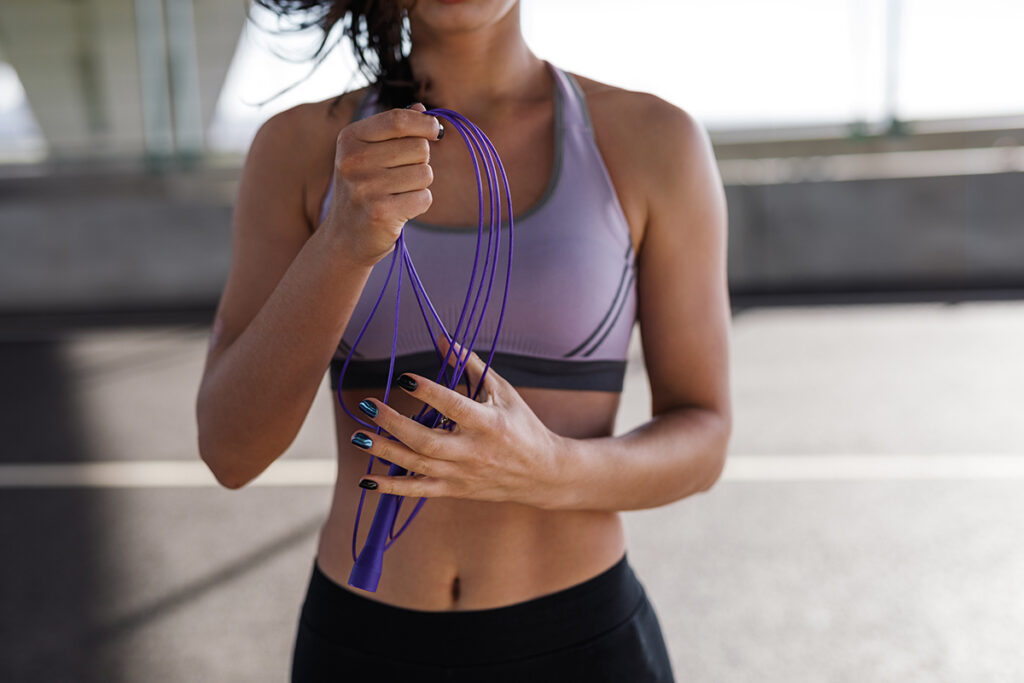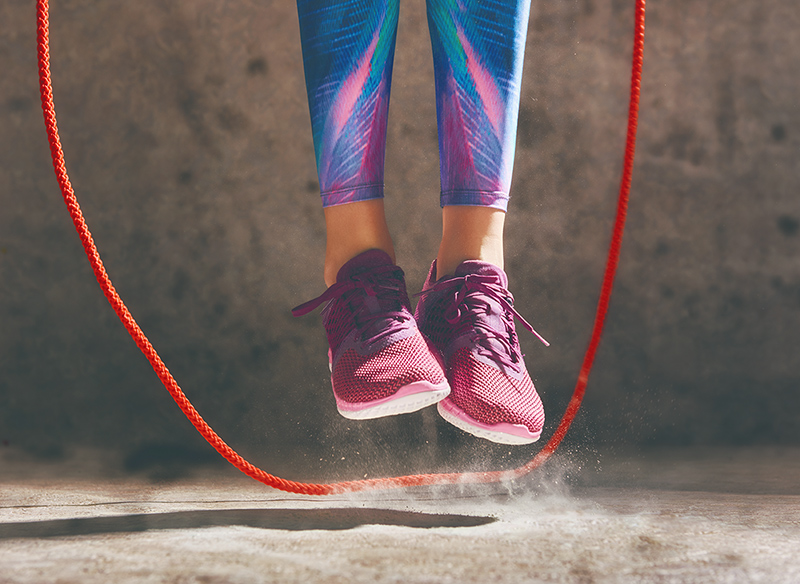Jumping rope, or skipping, is a simple but super effective way to get and stay fit. If you are looking for a no-frills way to exercise, something you can do at home or when you’re on the road, or simply an indoor workout when the weather isn’t great, look no further than jumping rope.
The Benefits of Jump Rope
Jump ropes are inexpensive, easy to find and hard-wearing. For $20.00 or less, you can buy a jump rope that will last you for years and deliver a great workout.
You can jump rope indoors or out and just about any time you like. No need to wait for the gym to open or the sun to rise. Once you have mastered the basics, you can do lots of fun jump rope tricks to make your workouts entertaining and varied. You can also jump rope to music and there are even group exercise classes.
Jump rope improves balance and increases agility, as well as developing eye, hand, and foot coordination. That’s why boxer’s use it as part of their workout program. Research shows that skipping rope does improve coordination and balance.12 Thus, this simple, unassuming but highly challenging activity can help improve your performance in other sports.
Weight bearing and high-impact, jumping has been shown to increase lower-body bone-density, which may help reduce the risk of suffering osteoporosis.3 It also strengthens your leg muscles, and improves cardiovascular health.
According to a study on 92 male students, 10 minutes of jumping rope may be equivalent to 30 minutes of jogging in improving cardiovascular fitness.4 A recent studied showed that jump rope improved performance in endurance runners.5
Although it looks like a lower body exercise, jumping rope is actually a full body workout. You’ll soon feel your shoulders, arms and upper back working along with your legs.
Of course, not all forms of exercise are suitable for everyone. As a high impact activity, jumping rope can be hard on your feet, ankles, knees and hips. Therefore, if you have health issues such as arthritis affecting those joints, get advice from a qualified health professional before getting started, as it may make jumping rope more challenging.
Read more: High-intensity exercises that are low-impact
Posture
How to Jump Rope with Proper Form

Jumping rope is a skill, and skills take time to master. Start off using this basic jump technique and then move on to more advanced jumps…
- With a handle in each hand, stand with your rope behind you and your feet together.
- With a flick of your wrists, circle the rope up and over your head. As the rope approaches your feet, jump up and over.
- Keep your jumps low – aim to only just clear the rope (about ½ – 1 inch off the ground). Land softly to minimise impact.
- Keep the rope turning and repeat.
Don’t worry if you trip – just reset your position and try again. Soon you’ll be doing ten, twenty, fifty or even one hundred rope turns without tripping!
Throughout, practice good posture:
- Head: Head and chest up, looking forward
- Arms: Arms and shoulders relaxed. Elbows down and back, at a 45-degree angle. Use only your wrists (not elbows or shoulders) to keep the rope turning. If using heavier rope, rotate with forearms.
- Hands: Your hands (and rope) should be positioned at the midline of your body, around hip-height.
- Core: Tall, neutral spine. Core engaged.
- Legs: Knees slightly bent throughout. Keep feet close together as you jump.
Remember not to sacrifice proper form for speed or volume. Keeping your jumps low isn’t just good technique, but also reduces the impact and stress on your joints. The higher you jump, the higher-impact it becomes, which makes jump rope more challenging.
Read more: Why you need to practice proper form
Tools
Essential Jump Rope Gear

There isn’t much you need to do to jump rope. Make sure you have the following things sorted, so your jump rope workouts are as productive and enjoyable as possible.
Best Type of Rope
There are lots of different types of jump rope you can buy. The key factors to consider are material and weight.
Material. Some jump ropes are made of leather, others are plastic and others still are metal wire. Plain old cotton ropes are usually too slow, so choose a “speed rope” instead. Speed ropes have the potential to be very fast, have light handles, are generally adjustable, and spin smoothly and easily without snagging.
Weight. If you’re a beginner, try a slightly weighted rope. This will give you more feedback than a light rope as you jump, as you’ll be able to feel the resistance of the rope more, which will help you time your jumps better.
Length of Rope
The length of your rope is key to getting a good workout and reduce trip ups. Jump ropes range from about 7 to 10 feet in length. As a rule of thumb the right length is approximately 3 feet longer than your height.
How to get the right length jump rope for your height:
- Stand on the middle of your jump rope and pull the handles up to your arm pits.
- A properly-sized rope should just reach your pits.
If your rope is too long, cut the rope to the right length. Alternatively, tie a knot near the handle to shorten it. Some ropes allow you to tweak the length of the rope without cutting it. If the rope is too short, get a longer one, as you’ll end up tripping all the time and risking injury.
Shoes
As a high impact activity, jumping rope puts a lot of stress on your feet and ankles so wear supportive, shock absorbing shoes when you jump rope. Running shoes or cross trainers are ideal.
Read more: How to choose the perfect shoe for every workout
Flooring
If possible, do your jump rope workouts on a forgiving surface and avoid concrete and cement floors. A wooden floor, matted floor or boxing ring is ideal. A gym mat placed over cement or concrete can help make it a little more forgiving.
If you have to jump rope on concrete, make sure your shoes are up to the job and keep your workouts relatively brief and infrequent.
You will also need plenty of space to jump rope – in front, behind and above. A fast-turning rope rope can be incredibly destructive so keep anything fragile out of the way!
While you can do double-footed rope jumps and get a good workout, you’ll get more from your jump rope training if you master a few more techniques.
Types of Jumps
Jump Rope Techniques

While you can do double-footed rope jumps and get a good workout, you’ll get more from your jump rope training if you master a few more techniques.
The bounce step is the basic jump rope step. Master this before moving on to the jogging step. Make sure you have a good command of these two basic steps before learning the more advanced jumping techniques.
- Bounce Step: Jump with both feet. Land lightly on the balls of your feet without letting your heels touch the floor.
- Jogging Step/ Alternate Foot Step: Rather than jumping with both feet at the same time, alternate your feet as though you were running on the spot. You should only ever have one foot on the floor at a time. Lift your knees to the front, without kicking your feet behind you (to avoid your feet catching rope). Your non-jumping foot can be lifted a little higher than an inch.
- Knee Lifts: From jogging on the spot, lift your knees forward and pump your legs high, so your thighs finish up roughly parallel to the floor
- High Knee Sprints: Keeping your knees high, pump your legs and spin your rope as fast as you can!
- Heel/ Toe: Rather than keep your feet together, land on one leg more than the other and kick your non-weight bearing leg forward so your heel touches the ground. Alternate legs step by step. This is also known as a boxers’ skip.
- Double Unders: Two rope turns per jump may look impossible but once you have mastered them, double unders are pretty awesome and very effective. Simply jump slightly higher and turn the rope faster so it passes under you twice per jump. With practice, you’ll be able to do ten, twenty or even fifty double unders. This exercise only really works with a fast, smooth speed rope.
- Cross Overs: Cross overs are a cool-looking move and also give your shoulders a brief rest. As the rope passes under you, hunch your shoulders and cross your hands in front of your hips. This creates a loop in the rope. Jump though the loop and quickly uncross your hands and return to normal rope jumping. If you are really fast you can do a double under cross over where you cross your hands as the rope passes under you the second time!
Cardio
Jump Rope Workouts

Combining different types of jumping steps and adding bodyweight exercises allows you to target different muscles and make your workout as easy or difficult as you want.
Give these fun jump rope workouts a try. Remember to adjust the number of exercises, jumps and time to suit of your fitness level.
Three-Minute Rounds
Jump rope for three minutes, rest for one minute and repeat. This is a good way to break up long jump rope workouts.
Pyramids
Do ten jump rope turns and then take a brief rest. Then do twenty and rest again. Keep adding ten more turns until you get up to one hundred. Then go back down doing ninety, eighty and so on until you get back to ten.
On completion, you’ll have done 1000 rope turns.
Tabata Intervals
For those with a high level of fitness! Jump rope as fast as you can for 20-seconds and then rest for 10-seconds.
Repeat eight to ten times for a short but intense workout
Read more: The ultimate guide to high intensity interval training
Burpees & Descending Pyramid
Do ten burpees and then jump rope 50 times. Do nine burpees and jump rope again 50 times.
Keep doing one less burpee until you get all the way down to one. Make sure you jump rope as fast as you can as this workout is against the clock.
30/30 Intervals
Jump rope for 30 seconds and then do a quick set of press ups – 10 or so is fine. Jump back up and skip for a further 30 seconds and then do a quick set of squats.
Continue alternating using your speed rope with press ups and squats for 15 to 20 minutes.
By mixing these techniques together, you can create a fun and varied workout that will be different each time you do it. There is no need to ever get bored jumping rope!

